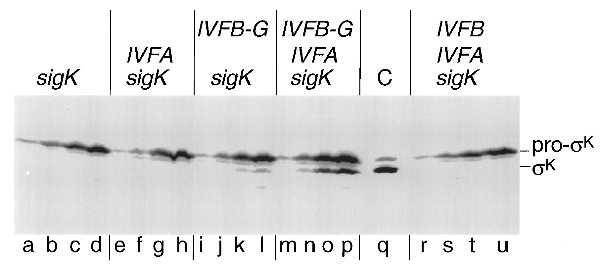Figure 3.

Pro-σK processing in cells engineered to produce a modified form of SpoIVFB during growth. A Western blot of cell extracts from B. subtilis cells is shown in which the genes or gene fusion that are listed above the blot were artificially induced during growth (except for lane C) and analyzed with a polyclonal antibody that recognizes both pro-σK and σK. The binding of the primary antibody was detected by using a colorimetric detection system. sigK refers to the gene encoding pro-σK, IVFA refers to the gene encoding SpoIVFA, IVFB refers to the gene encoding SpoIVFB, and IVFB-G refers to the gene fusion encoding the SpoIVFB-GFP protein fusion. Lowercase type (shown below the blot) refers to the individual lanes. Except for lane q, the lanes are divided into sets of four, with the first letter corresponding to 1 hr after induction, and each subsequent letter in the set indicating an additional hour of induction, up to 4 hr of induction. Details of the induction protocol are included in Materials and Methods. Lane q is a control lane of a cell extract from sporulating cells (at 6 hr after the initiation of sporulation) to indicate the electrophoretic mobility of both pro-σK and σK in this gel system (their relative positions are shown on the right). Cell extracts were prepared and an amount corresponding to 0.1 ml of cells was separated by SDS/PAGE. Lanes correspond to the following strains: a–d, OR910; e–h, OR920; i–l, OR916; m–p, OR918; r–u, OR922; q, OR9.
